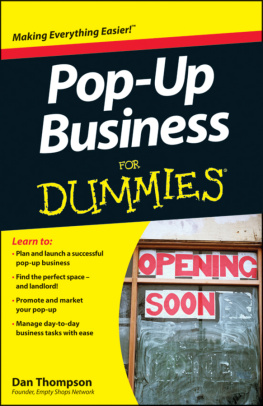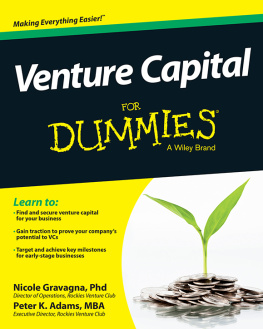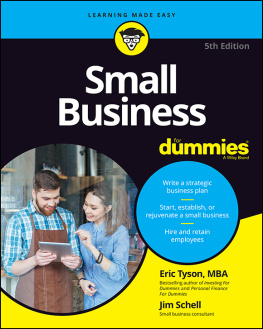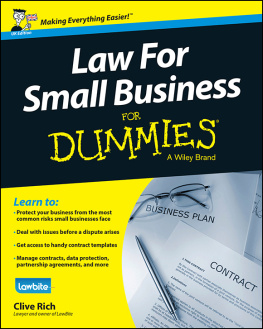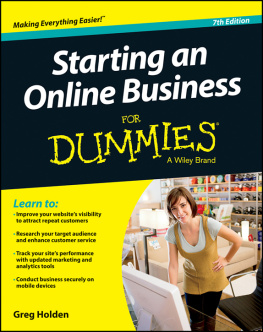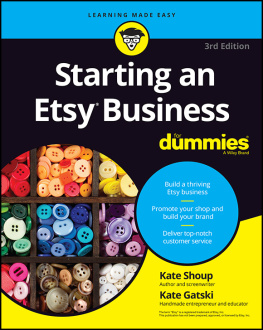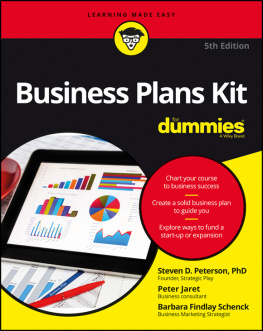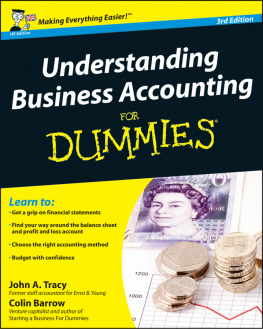
Pop-Up Business For Dummies
by Dan Thompson

Pop Up Business For Dummies
Published by:
John Wiley & Sons, Ltd The Atrium Southern Gate Chichester West Sussex PO19 8SQ England
www.wiley.com
2012 John Wiley & Sons, Ltd, Chichester, West Sussex.
Registered office
John Wiley & Sons Ltd, The Atrium, Southern Gate, Chichester, West Sussex, PO19 8SQ, United Kingdom
For details of our global editorial offices, for customer services and for information about how to apply for permission to reuse the copyright material in this book please see our website at www.wiley.com .
All rights reserved. No part of this publication may be reproduced, stored in a retrieval system, or transmitted, in any form or by any means, electronic, mechanical, photocopying, recording or otherwise, except as permitted by the UK Copyright, Designs and Patents Act 1988, without the prior permission of the publisher.
Wiley publishes in a variety of print and electronic formats and by print-on-demand. Some material included with standard print versions of this book may not be included in e-books or in print-on-demand. If this book refers to media such as a CD or DVD that is not included in the version you purchased, you may download this material at http://booksupport.wiley.com . For more information about Wiley products, visit www.wiley.com .
Designations used by companies to distinguish their products are often claimed as trademarks. All brand names and product names used in this book are trade names, service marks, trademarks or registered trademarks of their respective owners. The publisher is not associated with any product or vendor mentioned in this book.
Limit of Liability/Disclaimer of Warranty: While the publisher and author have used their best efforts in preparing this book, they make no representations or warranties with the respect to the accuracy or completeness of the contents of this book and specifically disclaim any implied warranties of merchantability or fitness for a particular purpose. It is sold on the understanding that the publisher is not engaged in rendering professional services and neither the publisher nor the author shall be liable for damages arising herefrom. If professional advice or other expert assistance is required, the services of a competent professional should be sought.
For general information on our other products and services, please contact our Customer Care Department within the U.S. at 877-762-2974, outside the U.S. at (001) 317-572-3993, or fax 317-572-4002.
For technical support, please visit www.wiley.com/techsupport .
A catalogue record for this book is available from the British Library.
ISBN: 978-1-118-44349-1 (pbk) ISBN: 978-1-118-44347-7 (ebk)
ISBN: 978-1-118-44346-0 (ebk) ISBN: 978-1-118-44348-4 (ebk)
Printed in Great Britain by TJ International Ltd, Padstow, Cornwall


Introduction
R ight now, towns and cities are filling up with pop up shops, pop up cinemas, pop up restaurants, pop up parks and pop up allotments. It seems like everythings a pop up now, and nothings permanent.
Of course, pop up has become a buzzword and is being applied to all sorts of things that arent really pop ups at all. So to be clear, a pop up is any project tailor-made to a specific space, which opens for a defined period of time, with a clear start and end date. More importantly, pop ups do something different, unusual and interesting; theyre not about the everyday way of doing things.
Pop ups have been around for a long time. We only have high streets because markets, the original pop ups, became permanent fixtures in town centres. And since the happenings and arts labs of the 1960s, seeing work by artists, actors and musicians in unlikely venues has become common practice.
So if its so old and so common, why is the term pop up everywhere right now, and why are people so interested?
People have realised that pop ups are a great way to do business. Theyre ideal if you want to test a new venture. Theyre perfect if you run a home-based business or sell on the Internet and want some extra exposure. They deliver magnificent results as part of a marketing or promotional campaign. And they help brands build real, lasting relationships with customers.
Theyre also far easier to do than ever before. People have moved to do their shopping online, at out-of-town centres where parking is easier and in supermarkets that stock everything. With more empty shops comes more opportunities to strike deals for short-term lets.
So pop ups meet the needs of a wide range of businesses, and the opportunities are there for people who want to take them. Pop ups are becoming normal, and part of the way businesses work.
But until now, nobody has provided a comprehensive guide to how to devise and deliver a pop up. Its been assumed that the people organising a pop up will muddle along, with a mix of skills in marketing, design, project management, retail and customer service. But pop up people need more than that; they need a specific way of working that embraces the temporary nature of what theyre doing and is agile and adaptable. This book is for those pop up people.
About This Book
This book is about creating, planning and delivering a pop up. If youve never opened a pop up before, this book helps you focus, keep on track and avoid mistakes. I show you how to gather the right people to help you and how to make them into a team that works together. And I help you with the more complicated issues, such as the legal aspects of a pop up and how to find funding.
You can also use this book as a reference, for subsequent pop ups. Youll find it useful if youve already opened some pop ups and want to make the process a little easier. And if youre thinking of making a pop up into a permanent shop, youll also find this book helpful as it covers some skills you need to make that transformation a success.
Beyond the loose definition I use in the previous section, this book doesnt define exactly what a pop up is, by the way. Think of pop up as a set of skills that you can apply to lots of different types of activity that can take place in lots of different spaces. Be as creative with your project as you can.
Conventions Used in This Book
This book is a jargon-free zone, because nothings complicated about pop ups. I avoid the technical terms used in business books, the arts world and in planning and regeneration circles and instead opt for using plain English. When I do introduce a new term, I italicise and define it.
The only jargon I cant avoid is the term pop up , of course! For this book, a pop up is any project in an empty shop or other empty space that is limited by time, with a clear start and end date. A pop up shop in a department store is not a pop up shop. A market is not a pop up market. Pop up shops are always temporary.
I use the word business throughout the book, to keep the writing concise; whenever I say business, I mean business, community group, social enterprise, arts organisation or even individual!
I also use the word shop , but I mean any space where you choose to pop up.
Foolish Assumptions
I assume that you want to start a pop up and have a good reason to do so. This book helps you by giving you lots of tips, tools and techniques to use.

